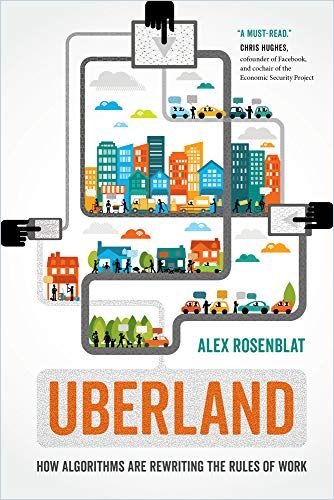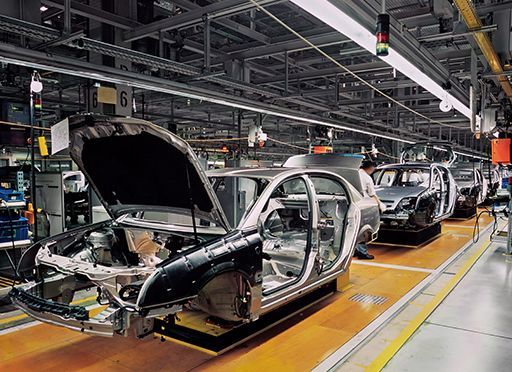Data researcher Alex Rosenblat examines Uber’s claims of enabling drivers/entrepreneurs and discovers the dark economic truths underlying its worldwide success.

Uber Exploits
Alex Rosenblat – a researcher at the Data & Society Research Institute and a technology ethnographer – shows what it’s like to work for Uber, and how technology enabled a sharing economy that’s changing the working world. She finds that Uber circumvents laws and regulations and exploits drivers through an algorithmic manager. As a result, Rosenblat discovered, Uber drivers don’t know their remuneration rates or working conditions as they deal with hostile passengers, shifting pay and unresolved conflicts. Despite these conditions, Rosenblat reports, many drivers like the flexible hours and enjoy their jobs.
The majority of Uber’s drivers work part time [with] three common motivations among them for doing this kind of work: It compensates for a career transition, it allows for much-needed flexibility or it fills the need for a good bad job.Alex Rosenblat
Publishers Weekly wrote, “This jargon-free and intriguing exposé offers food for thought for anyone interested in worker protections or societal changes driven by technology.” Slate said Uberland, “functions as an examination of both how Uber’s algorithms are changing the way companies operate and exert control over their workers and how those workers are experiencing these changes.” And The Los Angeles Review of Books said of Rosenblat, “Her analysis isn’t a polemic; it is balanced and measured.”
Sharing Economy
Rosenblat recounts how Uber emerged after the 2008 financial crisis as millions of Americans created a sharing economy by pooling resources via smartphone apps that connect buyers and sellers.
Uber, the author reports, calculates rates, processes credit cards and claims to maintain quality control by rating drivers and passengers. By the middle of 2017, she reports, Uber operated in 630 cities worldwide; by March 2018, three million active drivers drove for Uber.
Rosenblat cites myths that proliferate around Uber, including stories about sharing, technological exceptionalism and glamorized millennial labor.
The gig economy tech-washes this work into something more culturally desirable, but the passion and sharing rhetoric reinforce an older idea that workers in this line of work aren’t entitled to a living wage or labor protections.Alex Rosenblat
She reminds readers that gig work is lower-status labor, historically performed by women and people of color in agricultural and domestic arenas.
Motivations
Most drivers, the author found, work for Uber and Lyft part-time. Both companies, Rosenblat says, prefer part-timers, because Uber and Lyft have little incentive for improving pay or working conditions. Drivers, she underscores, cannot communicate with other drivers, which impedes labor organization on their part.
Rosenblat characterizes driving for Uber as a good bad job, like working in a factory or a restaurant. One crucial issue the author uncovered is that drivers can’t figure out how much they actually earn while also having to calculate their expenses for gas, maintenance, commercial insurance, self-employment taxes, and more.
Uber drivers in the US take home $10.87 per hour after deducting Uber fees, vehicle expenses, and the mandatory Social Security and Medicare taxes that self-employed drivers must pay.Economist Lawrence Mishel
Rosenblat finds proof of driver dissatisfaction in the fact that Uber loses roughly 25% of its workforce every three months. She scoffs at Uber’s claims that its drivers are entrepreneurs who set their own hours.
The author recounts how Uber Black and Uber Select pay more, so drivers upgrade their cars to drive for these services, but then Uber pressures them to take lower-tier gigs. Moreover, Rosenblat reveals, drivers never know what they’re going to get paid because Uber often cuts prices to increase demand, a practice that affects driver pay.
Rosenblat details how Uber’s algorithmic manager determines what cars are eligible for each platform; changes pay rates at a whim; controls the dispatching; rewards select drivers with incentives while punishing others; mediates and resolves conflicts; and suspends or fires drivers. And, she found, Uber tracks ride acceptance and ride-cancellation rates, and penalizes drivers for declining too often.
Middleman
Rosenblat reduces Uber to its essentials: Uber connects drivers and passengers, and takes a commission. Nobody but Uber knows the scale of that commission.
There are rumors flying around driver forums that Uber may sometimes convert the tips that passengers leave for drivers into a service fee that Uber pockets instead.Alex Rosenblat
Further, the author discloses, Uber undercuts drivers through unpaid cancellation fees, up-front pricing that doesn’t materialize, missing tips and manipulative surge pricing. Drivers, Rosenblat found, have only 48 hours to obtain cancellation fees. Uber keeps most of any missing money. Many drivers, she laments, don’t try to collect lost wages because Uber makes it so difficult.
Sexual Harassment
Adding to this, Rosenblat also describes how drivers face sexual harassment, payment problems and bad performance evaluations while Uber resolves conflicts via email, sending automated responses that frustrate drivers. Regarding sexual harassment, Rosenblat relates the saga of Susan Fowler, whose Uber manager harassed her. But, the author shows, the manager was a high performer whom the company refused to sanction. The author reminds readers that in June 2017, Uber fired its CEO, Travis Kalanick, because of this controversy.
The consequences of unfairness in rating systems are offloaded directly onto drivers, even when passengers put drivers in uncomfortable, dangerous or abusive situations.Alex Rosenblat
Rosenblat reports that Uber then sought to bolster its image by attempting to form partnerships with women-friendly nonprofit organizations such as Girls Develop It and Black Girls Code, but both turned Uber down.
Numbers and Humans
Rosenblat proves a worthy reporter with a finely honed and subtle sense of outrage. First, she provides the economic context of Uber’s rise, and then she details the larger worldwide trend of gig work. Only after providing this solid foundation, does she dissect, one by one, every claim Uber makes about itself. Her background leads Rosenblat at times to vest more heavily in data and numbers than every reader might desire, though the numbers consistently inform her arguments and illuminate the depth of Uber’s machinations.
The image of driver-as-entrepreneur fails for three main reasons: Drivers have no control over the rate at which they work; they do not determine which jobs they take while logged in; and they are routinely punished for any attempt to disrupt the system that Uber imposes.Alex Rosenblat
The author does not neglect the human aspect of her story, and offers telling, moving examples of drivers caught in Uber’s cogs. Rosenblat’s approach has value beyond her portrait of Uber. Her insights into its practices will help you understand the tactics of other large-scale “disrupters.”
Worthwhile works addressing similar or parallel issues include Ghost Work by Mary L. Gray, Automating Inequality by Virginia Eubanks and Blown to Bits by Hal Abelson.




